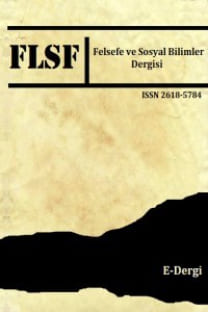ARTHUR DANTO VE GEORGE DICKIE’DE SANAT ETKİNLİĞİNİN KURUMSAL YAPISI
Bir sanat eleştirmeni ve filozof olan Arthur Danto, 1960’larda ‘sanat dünyası’ nosyonuna felsefi bir tanım kazandırmış ve sanatın doğasına ilişkin kültürel bir yaklaşım geliştirmiştir. Sonrasında ‘sanat dünyası’, George Dickie tarafından sosyal bir pratiğe gönderme yapan bir kurum olarak tanımlanmıştır. Bu çerçevede Dickie’nin formüle ettiği kurumsal sanat kuramı, çağdaş sanat yapıtlarına da açıklama getirebilmektedir. Kurumsal sanat kuramına göre, bir nesne ancak ve ancak ‘sanat dünyası’ olarak adlandırılan bir kurum bağlamında bir sanat yapıtı olarak ortaya konabilmektedir. Bu doğrultuda, hem çağdaş sanat tarafından etkilenen hem de çağdaş sanatı şekillendiren kurumsal kuram ve yaklaşımlar irdelenecektir
Anahtar Kelimeler:
Sanat Dünyası, Kurumsal Sanat Kuramı, Sanat Yapıtı, Sanatsal Etkinlik, İnsan Ürünü Nesne
Institutional Structure of Artistic Activity in the Philosophy of Arthur Danto and George Dickie
Arthur Danto, as an art critic and philosopher, gave the notion of ‘artworld’ a philosophical definition and presented a cultural approach about the nature of art and artistic activity in the 1960s. After that, the ‘artworld’ is defined by George Dickie as an institution that refers to a social practice. Within this framework, Dickie formulated an institutional theory of art that can explain also the contemporary works of art. According to the institutional theory, an object can only become art in the context of the institution known as ‘artworld’. So these approaches and institutional theories of art that have shaped and have been shaped by the contemporary art will be scrutinized
Keywords:
Artworld, Institutional Theory of Art, Work of Art, Artistic Activity, Artifact,
___
- Carrier, David, (1998), “Danto and his Critics: After the End of Art and History”, History and Theory, Volume 37, No. 4, Published by Blackwell Publishing by Wesleyan University, s.1-16.
- Danto, Arthur, (1964), “The Artworld”, The Journal of Philosophy, Volume 61, Issue 19, Published by Journal of Philosophy, Inc., s. 571- 584.
- Danto, Arthur, (1974), “The Transfiguration of the Commonplace”, The Journal of Aesthetics and Art Criticism, Volume 33, Issue 2, Published by the American Society for Aesthetics, s. 139-148.
- Dickie, George, (2001), Art and Value, Massachusetts, Oxford, Blackwell Publishers.
- Dickie, George, (2004), “The New Institutional Theory of Art”, in Aesthetics and the Philosophy of Art – The Analytic Tradition (An Anthology), Edited by Peter Lamarck and Stein Haugom Olsen, Blackwell Publishing, s. 47-54.
- Graves, David C., (2002), “Art and the Zen Master’s Tea Pot: The Role of Aesthetics in the Institutional Theory of Art”, The Journal of Aesthetics and Art Criticism, Volume 60, No. 4, Published by the American Society for Aesthetics, s. 341-352.
- Lenoir, Béatrice, (2005), Sanat Yapıtı, Çev.: Aykut Derman, İstanbul, Yapı Kredi Yayınları.
- Sclafani, Richard J., (1973), “Art as a Social Institution: Dickie’s New Definition”, The Journal of Aesthetics and Art Criticism, Volume 32, No. 1, Published by the American Society for Aesthetics, s. 111-114.
- Skidelsky, Edward, (2007), “But is it Art? A New Look at the Institutional Theory of Art”, Philosophy, Issue 02, Published by the Royal Institute of Philosophy, s. 259-273.
- Wartofsky, Marx W., (1980), “Art, Artworlds and Ideology”, The Journal of Aesthetics and Art Criticism, Volume 38, No. 3, Published by Wiley on behalf of The American Society for Aesthetics, s. 239- 247.
- Wieand, Jeffrey, (1981), “Can there Be an Institutional Theory of Art?”, The Journal of Aesthetics and Art Criticism, Volume 39, No. 4, Published by the American Society for Aesthetics, s. 409-417.
- Yayın Aralığı: Yılda 2 Sayı
- Başlangıç: 2006
- Yayıncı: Hamdi BRAVO
Sayıdaki Diğer Makaleler
DİL VARLIĞININ ONTOLOJİK ZEMİNİ
UZAY-ZAMANDA NESNELER VE BİLİNÇ
ARTHUR DANTO VE GEORGE DICKIE’DE SANAT ETKİNLİĞİNİN KURUMSAL YAPISI
DERRİDA’NIN İLETİŞİM ANLAYIŞINDA YİNELENEBİLİRLİK VE İMZA KAVRAMLARI
MODERNİTENİN MİRASI VE KRİZİ OLARAK DEMOKRASİ VE ÖTESİ
HUMAN RIGHTS IN THEORETICAL AND PHILOSOPHICAL SENSES
Habermasçı Müzakereciliğe Karşı
PLATON’DA KADIN SORUNU ÜZERİNE BİR TARTIŞMA
